 Image search results - "aga" Image search results - "aga" |
|
|
|
|
|
|
|
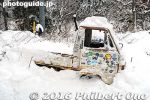
I'm told that this old truck has been abandoned here for many years. It has become a landmark at the end of the trail.
|
|
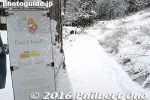
After walking 30 min. or so, signs of civilization. "Don't feed the monkeys and don't eat in front of the monkeys."
|
|
|

The Jigokudani Yaen Koen snow monkey park, where the snow monkeys live, is part of the Joshin-etsu Kogen National Park in Shiga Kogen Highland.
|
|
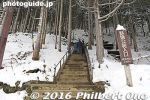
Go up these steps to the park admission gate.
|
|
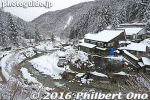
Jigokudani Onsen spa is near the snow monkey park. This ryokan named Korakukan has baths for humans and monkeys.
|
|
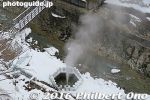
Jigokudani (Hell Valley) is a common name in Japan for valleys that have volcanic steam vents and other hot stuff. (Japan's image of hell is "hot.") However, this was the only steaming vent I saw in the valley.
|
|

Park rules
|
|
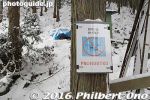
No drones
|
|
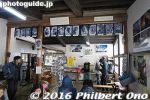
Near the monkey's onsen bath is this hut where you can take a break or warm up before heading back. It's literally a lifesaver. Wish they at least had a foot bath too.
|
|
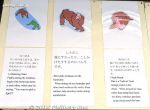
The hut has these informative sheets about the snow monkeys.
|
|
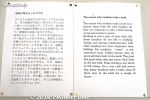
Why snow monkeys bathe in the hot spring.
|
|
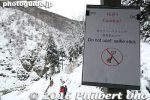
No selfie sticks.
|
|
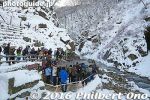
Walk all the way toward the back of the valley, pay the ¥500 park admission, and you'll see this. Tourists crowd around the onsen bath made especially for the snow monkeys.In a beautiful location next to the river. Just the day before, there was little snow here.
|
|
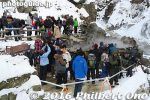
This is the only onsen bath where the monkeys bathe. All the photos of bathing snow monkeys you have seen were taken here. But not all monkeys bathe here. Only some of them bathe.The place is most crowded with tourists in the morning and lunch time. Most are foreign tourists, some Chinese too. Few Japanese tourists. The snow monkeys are more famous outside Japan than in Japan.
|
|
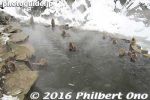
Humans don't bathe in here. The monkeys poop in the water so you may see poop floating around. No smell though.
|
|

Baby monkey. From generation to generation, these monkeys develop and pass down their habit of bathing in this hot spring.
|
|
|

Snow monkeys taking a bath and showing relaxed faces.
|
|

It's not unusual to see wild monkeys in Japan. So to the Japanese, these monkeys are not exotic nor unusual, even if they are bathing in an onsen.
|
|

Although monkeys appear in Japanese legends/folktales and may even serve as a divine messenger for certain Shinto gods, monkeys are generally viewed with disdain in Japan.
|
|
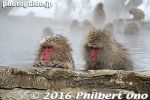
They steal food from souvenir shops, they can attack you for your bag of food, and they may hangout along the road for handouts from drivers.
|
|

My favorite shot. I'm not sure if he's exhibiting a derogatory gesture to us humans. The calluses on the buttocks serve as a cushion for sitting. It seems that they don't have the cushy/fatty buttocks that we do, so they need to grow calluses instead.
|
|
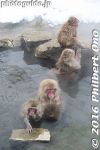
These monkeys are obviously accustomed to humans and they seem quite tame and well-behaved. As long as you keep your distance and don't disturb them or eat something in front of them.
|
|
|
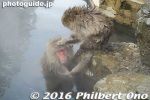
The monkeys always go comb through each other's fur for lice.
|
|
|
|
|
|

Baby monkeys have no fear of humans.
|
|
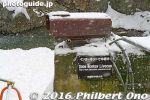
Next to the monkey spa is a live cam which you can see online here. You can see the monkeys bathing during the day and see how much snow there is.If you visit the snow monkeys, you can tell your friends to watch you on the live cam (updated every minute).
http://www.jigokudani-yaenkoen.co.jp/livecam/monkey/index.htm
|
|
|
|

Park staff throwing grain on the ground to feed the monkeys along the river.
|
|
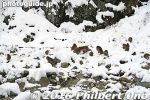
Lunch time for the monkeys.
|
|
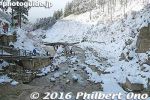
Immediately down river from the monkey spa, more monkeys roam and hangout.
|
|
|
|
|
|
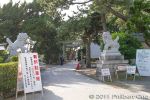
Entrance to Morito Daimyojin Shrine on the Morito Coast. 森戸大明神
|
|
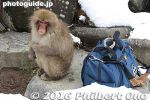
Monkey totally ignored this bag.
|
|
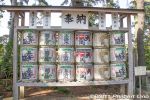
Sake barrels.
|
|
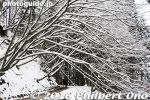
I must say that having snow is the key here. Without it, it wouldn't be worth the trouble of coming here.More info about the snow monkey park: http://en.jigokudani-yaenkoen.co.jp/about
|
|
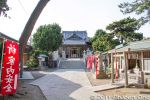
Morito Daimyojin Shrine on the Morito Coast. 森戸大明神
|
|
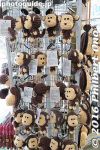
Monkey souvenirs at the gift shop at the trail's entrance.
|
|
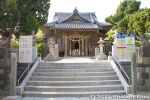
Morito Daimyojin Shrine on the Morito Coast. The Najima torii in the ocean belongs to this shrine. 森戸大明神
|
|
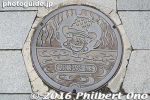
Manhole in Shibu Onsen showing a snow monkey in a bath. Shibu Onsen is near the entrance to the trail to the monkey park.
|
|
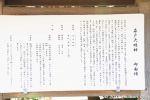
About Morito Daimyojin Shrine.
|
|
|
|
|
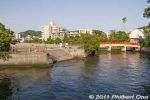
Morito River and Misogi Bridge. みそぎ橋
|
|
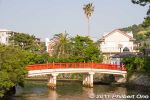
Misogi Bridge. みそぎ橋
|
|
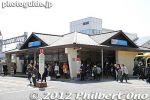
The Matsuda Sakura Matsuri is held from mid-February to mid or late March. The cherry blossoms bloom in mid-March or later if it's a cold winter like in 2012. Near Odakyu Shin-Matsuda Station (80 min. from Shinjuku).
|
|
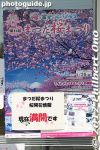
On a hillside near Odakyu Shin-Matsuda and JR Matsuda Stations, a large patch of cherry blossoms bloom in March. These are early-blooming (hayasaki) sakura. The place is spectacular when the cherries are in full bloom.
|
|
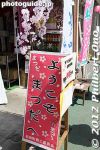
Welcome sign
|
|
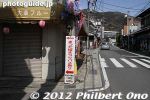
From Odakyu Shin-Matsuda Station, signs point the way to the shuttle bus stop in front of JR Matsuda Station.
|
|
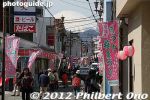
Shopping street toward JR Matsuda Station with a view of Mt. Fuji.
|
|
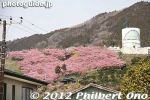
The pink patch of early-blooming (hayasaki) cherry trees on the slope of Mt. Matsuda-yama near JR Matsuda Station.
|
|
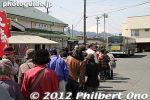
In front of JR Matsuda Station, a long line forms to board the shuttle bus to the Matsuda Sakura Matsuri. This was on a weekday when the flowers were in full bloom. Possible to walk, but it's uphill. Bus (150 yen) comes frequently when it's crow
|
|

Map of Matsuda Cherry Blossom Festival site on the slope of Matsuda-yama. It is a hillside park called Nishihirabatake Park. Lots of Kawazu sakura trees.
|
|
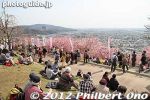
The site is spectacular with views of the town below, the ocean, and Mt. Fuji.
|
|
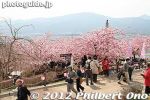
These Kawazu cherry trees bloom in late February to mid-March. They bloom for about a month and have a pinker color than the Somei Yoshino sakura.
|
|
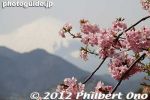
Mt. Fuji and cherry blossoms from Matsuda, Kanagawa. Kawazu cherry trees (河津桜) are named after a place in Shizuoka Prefecture called Kawazu where the original tree was first discovered in 1955.
|
|
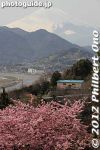
Mt. Fuji and cherry blossoms from Matsuda, Kanagawa.
|
|
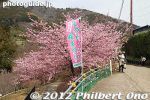
After arriving by bus, walk uphill to see the upper cherry trees here.
|
|
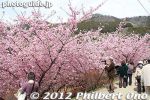
Kawazu cherry trees along the upper part of Nishihirabatake Park.
|
|
|
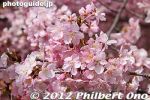
Kawazu sakura (河津桜) is a variety of cherry blossom which blooms earlier and longer than the Somei Yoshino variety. They also have a darker pink color.
|
|
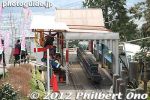
Train ride for kids.
|
|
|
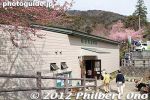
At the end of the short trail is a small Nature Museum.
|
|
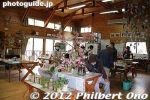
Inside the Nature Museum.
|
|
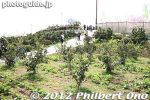
Tangerine trees.
|
|
|
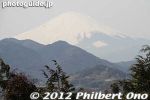
View of Mt. Fuji. Somewhat hazy this day in late March 2012.
|
|
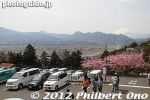
Driving is not recommended. Parking lot is small and road is snarled.
|
|
|
|
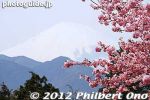
Mt. Fuji and kawazu sakura cherry blossoms in Matsuda, Kanagawa.
|
|
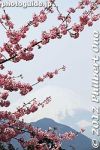
Mt. Fuji and kawazu sakura cherry blossoms in Matsuda, Kanagawa.
|
|
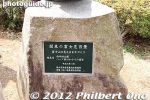
Marker for one of the 100 Best Views of Mt. Fuji in the Kanto region.
|
|
|
|
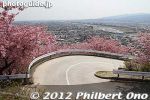
The road going up to the park is very narrow and kind of hairy. The crowded bus chugged along upward. One giant earthquake and I bet it would toppled over and down the slope.
|
|
|
|
|
|
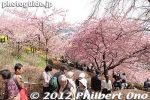
There is a spectacular trail lined with cherry blossoms going down the mountain.
|
|
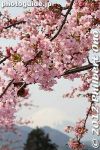
Mt. Fuji and kawazu sakura cherry blossoms in Matsuda, Kanagawa.
|
|
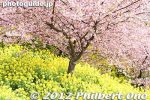
Another element making the park spectacular are these numerous, bright-yellow rape blossoms (nanohana).
|
|
|
|
|
|
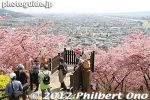
Lookout deck.
|
|
|
|
|
|
|
|
|
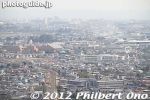
View of Matsuda town.
|
|
|
|
|
|
|
|
|
|
|
|
|
|
|
|
|
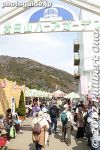
Food stalls next to the Herb Pavilion.
|
|
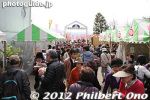
Crowded food stalls.
|
|
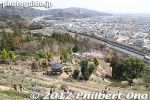
Nishihirabatake Park also has a Herb Garden.
|
|
|
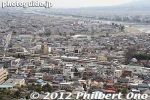
Views of Matsuda from the Matsudayama Herb Garden.
|
|
|
|
|
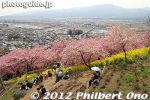
Cherry trees on the slope of Matsudayama.
|
|
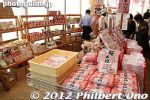
Shop inside the Herb Pavilion.
|
|
|
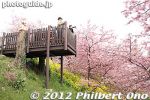
Lookout deck.
|
|
|
|
|
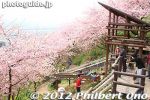
Slider for kids.
|
|
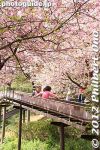
Slider for kids.
|
|
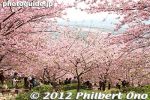
In the evening from mid-March, the trees are lit up.
|
|
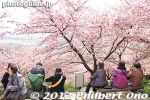
The cherry trees just go on and on as you go walk down the slope. It's a lot easier to take the shuttle bus up to the park and walk down rather than hiking up and taking the bus down.
|
|
|
|
|
|
|
|
|
|
|
|
|
|
|
|
|
|
|
|
|
|
|
|
|
|
|
|
|
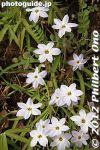
These small flowers got no attention. Poor thing.
|
|
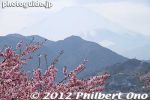
Mt. Fuji from Matsuda, Kanagawa.
|
|
|
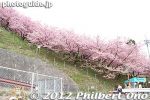
Cherry trees on the slope of Matsudayama.
|
|
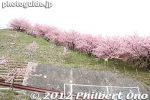
Cherry trees on the slope of Matsudayama.
|
|
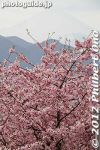
Mt. Fuji and cherry blossoms.
|
|
|
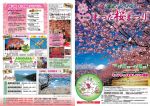
Matsuda Sakura Festival brochure.
|
|
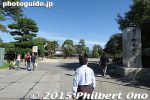
Matsumoto Castle is one of Japan's five castles with the main tenshu tower designated as a National Treasure. Near JR Matsumoto Station.
|
|
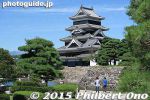
The castle is surrounded by a moat in a park-like area.
|
|
|
|
|
|
|
|
|
|
|
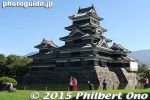
Matsumoto Castle
|
|
|
|
|
|
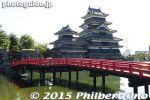
The red bridge provides a nice accent for the Matsumoto Castle tower.
|
|
|
|
|
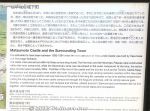
About Matsumoto Castle town
|
|
|
|
|
|
|
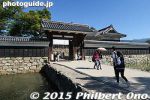
Gate to enter the main castle compound.
|
|
|
|
|
|
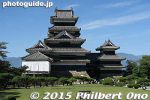
Matsumoto Castle
|
|
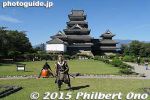
Samurai greets visitors to Matsumoto Castle.
|
|
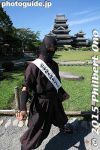
Koka ninja greets visitors to Matsumoto Castle in Matsumoto, Nagano.
|
|
|
|
|
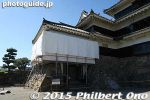
One room was being renovated in Oct. 2015.
|
|
|
|
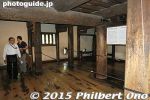
Inside Matsumoto Castle.
|
|
|
|
|
|
|
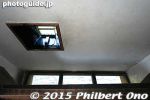
To drop stones.
|
|
|
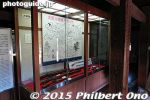
Inside Matsumoto Castle is a Gun Museum.
|
|
|
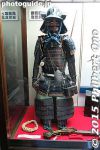
Samurai armor
|
|
|
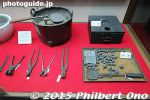
Bullets
|
|
|
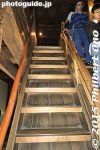
One of the steep stairs in Matsumoto Castle. Tight skirts and miniskirts not recommended.
|
|
|
|
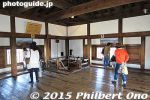
Top floor of Matsumoto Castle.
|
|
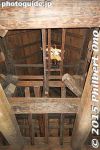
Ceiling on top floor.
|
|
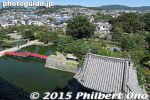
View from top of Matsumoto Castle.
|
|
|
|
|
|
|
|
|
|
|
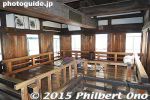
The room being renovated.
|
|
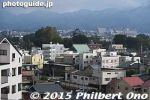
Mastumoto Castle tower visible from our hotel.
|
|
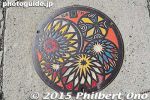
Matsumoto manhole
|
|
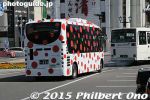
Polka dot bus advertising Kusama Yayoi's exhibition in a local museum. Matsumoto is her hometown.
|
|
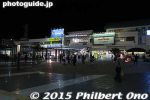
Matsumoto Station at night.
|
|
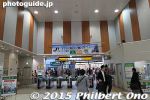
Matsumoto Station
|
|
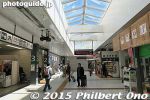
Matsumoto Station
|
|
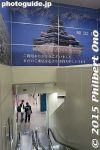
Matsumoto Station
|
|
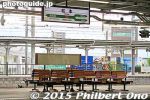
Matsumoto Station train platform
|
|

Near Mukojima Hyakkaen Garden are seven shrines for the Sumidagawa Seven Gods of Good Fortune (Sumidagawa Shichi-fukujin 隅田川七福神めぐり). This is a map of the seven shrines.
|
|
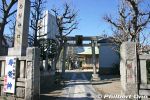
Near Mukojima Garden is Shirahige Shrine in Higashi Mukojima, Sumida-ku, Tokyo. Dedicated to the God of Longevity, it's one of the Sumidagawa Seven Gods of Good Fortune. 白鬚神社
|
|
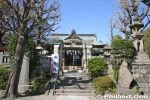
Shirahige Shrine in Higashi Mukojima, Sumida-ku, Tokyo. "Shirahige" literally means "white beard," a sign of old age and longevity. The shrine worships Sarutahiko Ōkami for strength and guidance.
|
|
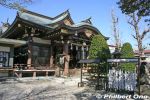
Shirahige Shrine in Higashi Mukojima, Sumida-ku, Tokyo is also a branch shrine of Shirahige Shrine in Takashima, Shiga Prefecture. 白鬚神社
|
|

Next to Miidera temple's southern boundary is Nagara Shrine. The shrine is not part of Miidera, but it is often included in maps of Miidera temple. 長等神社
|
|

Built in 1905, gate of Nagara Jinja Shrine.
|
|

In 860, Miidera Founder Enchin worshipped this shrine as the guardian deity of Miidera.
|
|

Nagara Shrine Honden Hall. The original shrine was atop the mountain, but it was later moved here in 1054 at the foot of Mt. Nagara to make it more accessible to worshippers.
|
|

Maruko-bune Museum (Maruko-bune no Yakata). The maruko-bune was commonly used to transport cargo over the lake from the Hokuriku region to the Kyoto-Osaka region during the 17th and 18th c. MAPThe museum is a short bicycle ride from Nagahara Station (JR Kosei Line). 滋賀県西浅井町大浦582 丸子船の館
|
|

Maruko-bune wooden boat which was a common sight on Lake Biwa in the old days before trains came to fore. Near this area was a major maruko-bune port called Oura.
|
|

Maruko-bune, a traditional wooden boat mainly for shipping cargo across Lake Biwa in the old days. This used maruko-bune was donated by a local resident. 丸子船
|
|

Black copper plates decorate the bow (ダテカスガイ). This checkered pattern was unique to Lake Biwa boats. The wood seams are stuffed with conifer fiber (槙縄) to repel water.
|
|

Maruko-bune's trademark is this half-round cedar or cypress log on both sides. おも木
|
|

The bow's tip is studded.
|
|

Maruko-bune were a vital transportation link between northern Japan and Kyoto/Osaka. Goods coming and going via the Sea of Japan also went over the lake.
|
|

Rudder hangs down from a torii-like brace (かさ木), also used as a mast rest when the mast is laid down. Most of the wood is Japanese conifer (槇の木).
|
|
|

The sail is made of thick cotton material, replacing the old straw mat that didn't last long.
|
|
|
|

This maruko-bune is 17.2 meters long.
|
|

Top view of maruko-bune.
|
|

During the 17th and 18th-centuries, over 1,000 maruko-bune sailed on the lake. The busiest ports were Shiotsu in the north and Otsu. After railroads were built, maruko-bune dwindled. Today, there are no maruko-bune on Lake Biwa.
|
|
| 10841 files on 44 page(s) |
 |
 |
23 |  |
 |
|